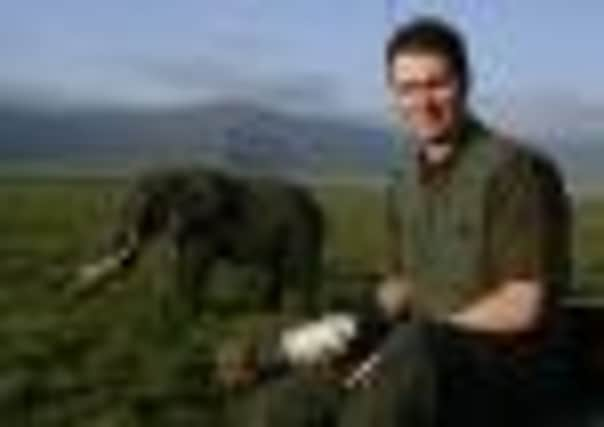Transfixed by a leap of faith


You can drive from dawn to dusk and never see the end of the long fluid lines of wildebeest, zebra and Thomson’s gazelle as they search for new pasture.
Although it is called a migration, it is really a continuous trek across the vast Serengeti plains, in Tanzania, up into the northernmost stretch of those same plains in Kenya’s Masai Mara, and back again.
Advertisement
Hide AdAdvertisement
Hide AdSome million-and-a-half wildebeest, hundreds of thousands of zebra, and equal numbers of gazelle, move together in a vast convoy that literally follows the rainfall.
The way this happens is almost miraculous. I’ve been there when huge, grey clouds have broken over empty, parched plains in dramatic rain storms. Then, the very next morning I’ve woken to see the same landscape dotted with a wildebeest and antelope.
Despite having seen this event five times now, there is something so momentous about the sheer numbers of animals all present at once that I am drawn back there.
The highlight of these trips has been when I have watched these animals cross the Mara River in Kenya’s Masai Mara.
Advertisement
Hide AdAdvertisement
Hide AdNothing quite prepares you for the way in which the huge herds plunge mindlessly into these crocodile-infested waters. So driven are they by the age-old instinct that the grass is greener on the other side, that many of them leap to their certain deaths.
I’ve seen wildebeest gather on the bank, their numbers building sometimes for days, until one brave beast suddenly takes the plunge, or is perhaps pushed, and as it does so, it sparks off a noisy clamour as tens of thousands of animals follow suit.
The noise can be deafening and as the animals begin to reach the other side, calves often get separated from their mothers, and zebras bray frantically as the stallions try to regroup their family members.
The anguish is palatable. And it feels as though the frenzy will never end as, all the time, more and more animals keep jumping into the water, which itself looks like a river of seething mammals.
Advertisement
Hide AdAdvertisement
Hide AdI once watched a family group of zebras cross. This group seemed to have put a bit more planning into the crossing than the wildebeest do and as the dust cleared a little, I saw the stallion looking over the bank as if searching for crocodile below.
He clearly decided that the coast was clear, perhaps when he saw herds of wildebeest safely on the other bank, because he then carefully led his family into the water. Last in was a very young foal.
Suddenly, seemingly out of nowhere, a crocodile appeared and rushed toward the foal.
My heart was in my mouth as I watched the foal disappear beneath the water. But then it popped back up just a short distance away. The crocodile then pulled it under again, and then, just as quickly, let it go again.
Advertisement
Hide AdAdvertisement
Hide AdI assumed it was playing with it, because it could have easily taken it. Perhaps it had already had its fill.
As the foal scrambled up the bank on the other side of the river, I breathed a sigh of relief.
Crocodiles are not the only dangers these animals face. On both banks lurk prides of lions, and all this activity doesn’t go unnoticed by the leopard that favour the Mara’s wooded river banks and gorges, and the cheetah that patrol the savannah.
Lion are fiercely territorial, and this part of the Mara is home to the very pride that is being followed by the BBC TV’s Big Cat Diary series.
Advertisement
Hide AdAdvertisement
Hide AdAt this time of year, this territory is particularly desirable, and these formidable animals are constantly on the look-out for rival prides who may want to encroach on their ‘patch’.
They roar to mark out the boundaries of their territory and to warn off rivals.
You can hear a lion’s roar eight kilometres away and the sound is truly spine-tingling. The first time I heard it, I could feel the vibrations in my chest.
Because there are so many herds gathered in one place, the Mara River is the best place to see these great predators. I have seen 14 cheetah and 30 lion in just one day, and over the years have even seen the very cats that star on the TV series.
Advertisement
Hide AdAdvertisement
Hide AdOf course, there are also elephant, giraffe, a huge variety of antelope, bat-eared foxes, servile cats, great birdlife and much more.
All this wildlife makes the Mara one of the best wildlife viewing destinations in the world.
But the spectacle is almost impossible to describe, photograph or even film adequately.
Even the best wildlife documentary does not convey what is truly the greatest wildlife show on Earth.
Advertisement
Hide AdAdvertisement
Hide AdSomehow, these media never quite do justice to the vastness of the landscape and the herds that move across them. The only thing to do is see it for yourself.
Artist Robert Fuller will be leading a game-viewing safari through Kenya’s Masai Mara this August. If you are interested in joining him, contact 01759 368355 or [email protected]. He will also be giving a talk and slideshow about his experiences in the Masai Mara, at his gallery, at Fotherdale Farm, Thixendale, on March 17, at 7.30pm.